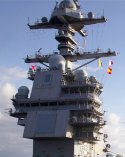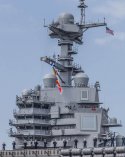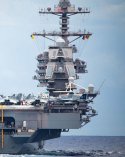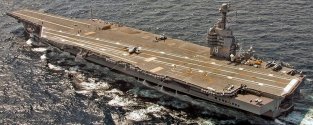There are three changes from Fujian that need to be tested before moving toward serial production of a hypothetical main carrier.
- nuclear propulsion - Fujian is conventionally powered
- supercarrier architecture - Fujian is not a proper supercarrier
- UCAV optimisation - Fujian is optimised for manned aircraft
Each of the three carriers had an elementary task:
- 001 - acquire a carrier to learn carrier ops
- 002 - build a carrier to learn how to build a functional carrier, therefore a known design must be chosen
- 003 - design and build a carrier to learn how to design and build a carrier, therefore a new but similar design must be chosen
001 to 003 is a well understood learning curve in any design & build enterprise so 004 will be the first opportunity where new solutions can be introduced without disruption.
I would argue that supercarrier architecture - a larger deck with three lifts, matching as closely as possible Ford layout - is much harder to achieve than nuclear propulsion. Nuclear propulsion is relatively straightforward and provides savings of storage space which in turn allow for more flexibility when designing the interior. Supercarrier layout on the other hand requires training some 1000 people in completely new level of intensity of operations.
Fujian probably has 50% of Fords peak sortie generation rate and growing that number is disproportionately complex which is why it took this long to improve it. What Ford achieved is a lesson from decades of service and PLAN is in the unique position of not having to go through all that time and effort to implement the lessons.
UCAV optimisation is another issue that I haven't seen discussed because most discussions on PLAN carriers focus on the wet dreams of fanboys, and those tend to resemble scripts to their beloved childhood mega-robot cartoon series rather than what the discussion is in actual design groups of people who come up with new carriers.
UCAVs change everything because they eliminate the most valuable and most vulnerable element in manned flight - the pilot. You can greatly increase tempo because AI pilots don't need rest (but your crews do) only refuel and rearm. You can relax safety procedures which are aimed at protecting pilots. UCAVs can be crashed and discarded if necessary. They can take off and land at greater g loads so the tempo is higher there as well. Probably the entire deck will a have to be redesigned to allow for regular tempo manned ops and higher tempo unmanned ops. Because UCAV will only need decision nodes to be manned there is less need for manned planes in each sortie lot.
USN carriers are built for 50 years of service. There simply isn't room for designing an outdated carrier at the theshold to a completely new era in combat air operations. I don't know to what extent Ford's designers took UCAVs into account but I wouldn't be surprised if they didn't. Ford is a 2000s design and 2010s brought a complete change in thinking as AI began to bring results. 2030s are when we will see UCAVs employed as loyal wingmen on a regular basis and from there it's autonomous operations in a manned-unmanned networks in the 2040s.
If 004 was laid down in 2025 then it would enter service in 2032-34 at the absolute earliest. If it isn't considering UCAV operations then it's like designing an ironclad after HMS Dreadnought. I think that may force some kind of pause in thinking and I wouldn't be surprised if Type 076 was a test ship for some of those solutions. Perhaps the necessary redesign isn't a major issue but it can't be certain until there is some testing done.
To add on the above statement, these CGI models by Big Bun CG on Weibo does the illustration pretty well.
View attachment 136451
From left to right:
#1 - Island superstructure of Fujian CV, actual design (34 meters long at base, 41 meters long for overhang)
#2 - Island superstructure of Fujian, but with the exhaust funnel removed, hypothetical design (23 meters long at base, 30 meters long for overhang)
#3 - Island superstructure that is a further squeeze of the 2nd one, hypothetical design (22 meters long at base, 19 meters long for overhang)
#4 - Island superstructure of Ford-class CVN, actual design (18 meters long at base, 23 meters long for overhang)
#4 is completely wrong. Ford's island looks like this - don't just look at it, try to understand why it looks like it does and what's going on inside.



Notice the
four levels of the bridge of which only one - main bridge - extends to both sides. The other three are for deck operations so their field of view concerns deck space. #4 is horribly inefficient design for high volume operations.
And this is how it's placed on deck

If you look at what approach paths aircraft take it seems natural to want a bridge that covers 180 degrees toward the port to have full view of deck. Ford's island has the view obstructed by radar panels. If you go back to the close-ups you'll easily see where the internal space is taken by all the electronics and wiring and cooling systems, as well as service access.
If China is smart they'll lose the main phased arrays on the island mast, which is exactly what the director of Ford development program indicated as the main thing he would change in the final design. Carriers really don't need to have the type of radar that AAW escorts do. It serves no purpose other than waste space, energy and money. They are an equivalent of a huge beacon that says "right here" stuck on top of the main asset in the task force. Without the radars the island can be made even smaller and the bridge can be arranged more efficiently. Without main radars the island also is much less top-heavy which lightens the structure, reduces need for space and makes it possible to move the island to a more convenient spot on the deck. There is no thing such as "too much deck space" on a carrier so even if it allows to move it a few meters toward the starboard it is a gain.
At this point, considering how much work optimised design requires adding nuclear propulsion is a no-brainer. The French could do it with De Gaulle and that's a barely functional design.
And as for future designs - UCAVs will change everything. No pilots means no human limitation for operating conditions. What kinds of carriers and exactly
how many of them do you really need if your aircraft can stay in the air for 24 or 72 hours with refueling or fly missions that require 6 or 8 hours of flight each way? There always will be room for traditional operations where manned fighters will be necessary even if only as decision nodes enabling 10x or 20x the amount of UCAVs. But there are so many other options available once you take the human out of the equation that it validates rethinking the entire concept.





